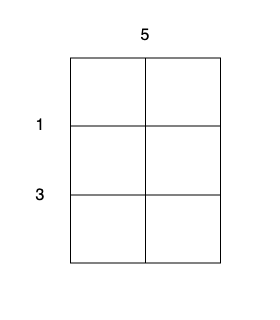Description
There is an m x n cake that needs to be cut into 1 x 1 pieces.
You are given integers m, n, and two arrays:
horizontalCutof sizem - 1, wherehorizontalCut[i]represents the cost to cut along the horizontal linei.verticalCutof sizen - 1, whereverticalCut[j]represents the cost to cut along the vertical linej.
In one operation, you can choose any piece of cake that is not yet a 1 x 1 square and perform one of the following cuts:
- Cut along a horizontal line
iat a cost ofhorizontalCut[i]. - Cut along a vertical line
jat a cost ofverticalCut[j].
After the cut, the piece of cake is divided into two distinct pieces.
The cost of a cut depends only on the initial cost of the line and does not change.
Return the minimum total cost to cut the entire cake into 1 x 1 pieces.
Example 1:
Input: m = 3, n = 2, horizontalCut = [1,3], verticalCut = [5]
Output: 13
Explanation:

- Perform a cut on the vertical line 0 with cost 5, current total cost is 5.
- Perform a cut on the horizontal line 0 on
3 x 1subgrid with cost 1. - Perform a cut on the horizontal line 0 on
3 x 1subgrid with cost 1. - Perform a cut on the horizontal line 1 on
2 x 1subgrid with cost 3. - Perform a cut on the horizontal line 1 on
2 x 1subgrid with cost 3.
The total cost is 5 + 1 + 1 + 3 + 3 = 13.
Example 2:
Input: m = 2, n = 2, horizontalCut = [7], verticalCut = [4]
Output: 15
Explanation:
- Perform a cut on the horizontal line 0 with cost 7.
- Perform a cut on the vertical line 0 on
1 x 2subgrid with cost 4. - Perform a cut on the vertical line 0 on
1 x 2subgrid with cost 4.
The total cost is 7 + 4 + 4 = 15.
Constraints:
1 <= m, n <= 20horizontalCut.length == m - 1verticalCut.length == n - 11 <= horizontalCut[i], verticalCut[i] <= 103
Code
Time Complexity: , Space Complexity:
暴力法 + memoization。
class Solution {
public:
int minimumCost(int m, int n, vector<int>& horizontalCut, vector<int>& verticalCut) {
vector<vector<vector<vector<int>>>> memo(m + 1, vector<vector<vector<int>>>(m + 1, vector<vector<int>>(n + 1, vector<int>(n + 1, -1))));
return tryToCut(0, m, 0, n, horizontalCut, verticalCut, memo);
}
int tryToCut(int h_start, int h_end, int v_start, int v_end, vector<int>& horizontalCut, vector<int>& verticalCut, vector<vector<vector<vector<int>>>>& memo) {
if(memo[h_start][h_end][v_start][v_end] != -1) {
return memo[h_start][h_end][v_start][v_end];
}
if(((h_end - h_start) == 1) && ((v_end - v_start) == 1)) {
return memo[h_start][h_end][v_start][v_end] = 0;
}
int minCost = INT_MAX;
for(int i = h_start + 1; i < h_end; i++) {
minCost = min(minCost, horizontalCut[i - 1] + tryToCut(h_start, i, v_start, v_end, horizontalCut, verticalCut, memo) + tryToCut(i, h_end, v_start, v_end, horizontalCut, verticalCut, memo));
}
for(int i = v_start + 1; i < v_end; i++) {
minCost = min(minCost, verticalCut[i - 1] + tryToCut(h_start, h_end, v_start, i, horizontalCut, verticalCut, memo) + tryToCut(h_start, h_end, i, v_end, horizontalCut, verticalCut, memo));
}
return memo[h_start][h_end][v_start][v_end] = minCost;
}
};